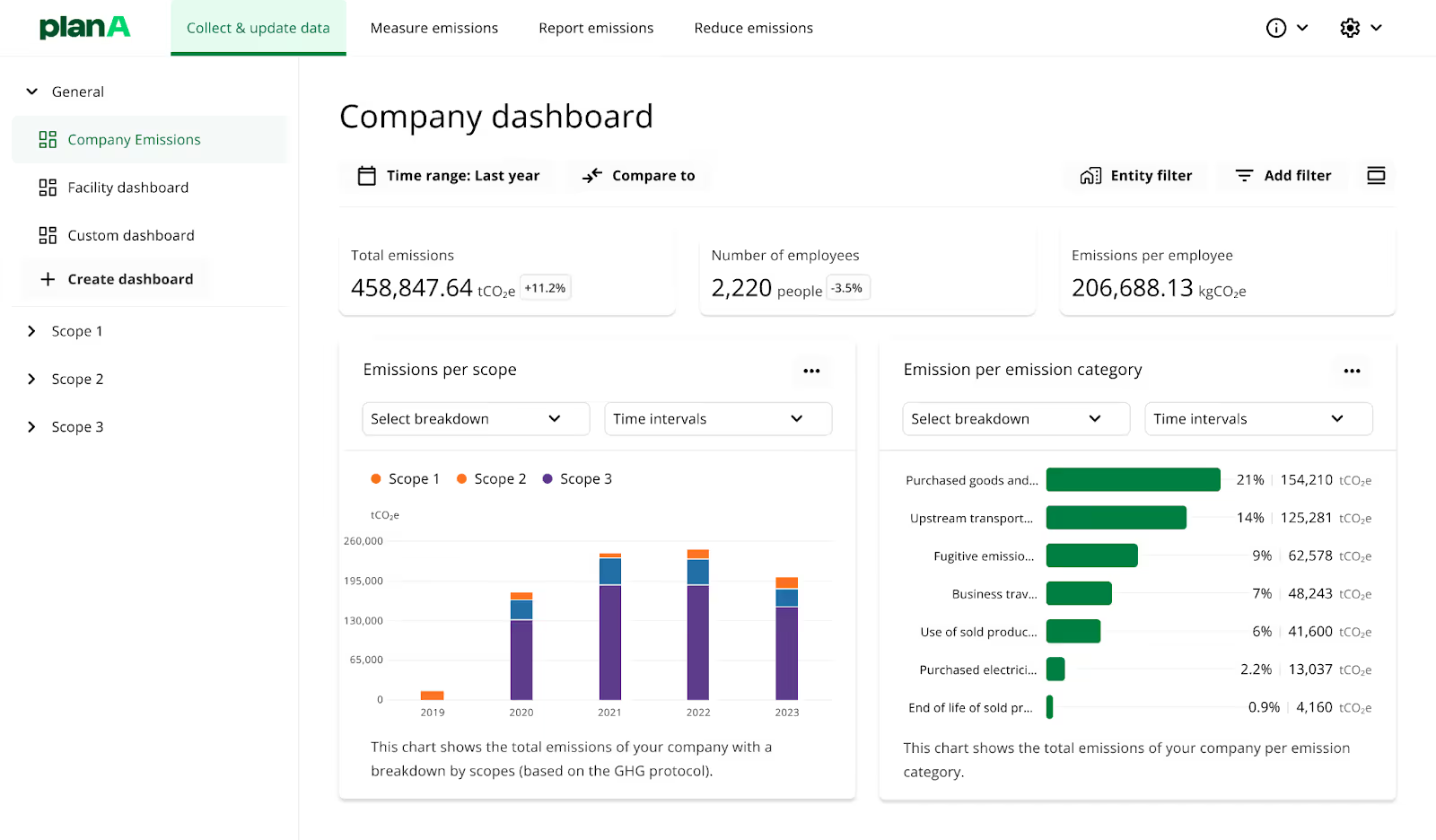Sustainable procurement became essential for any business aiming to stay competitive and responsible. You're wrong if you think it’s only just cutting costs. Nowadays, it’s more about making smarter choices that can significantly reduce your company’s environmental impact and show your customers and suppliers that you’re serious about sustainability.
In other words, having a sustainable supply chain can boost your reputation while helping you avoid penalties. Plus, it’s vital to hitting bigger sustainability goals, like decarbonisation and cutting scope 3 emissions, often the largest chunk of a company’s carbon footprint—more details are coming in this article.
What are sustainable procurement policies?
Definition of sustainable procurement

Credit: Unsplash
Sustainable procurement is a long-term approach to purchasing that considers the broader impact of business decisions on the environment, society, and the economy.
In other terms, it’s about making sure that what your company buys offers value for money over its entire life cycle while doing as little harm as possible to the planet. This means looking beyond the simple price of materials, energies or services and considering factors like how a product is made or how it contributes to the well-being of the people involved in its production.
For example, this involves:
- Selecting suppliers regarding their environmental practices;
- Evaluating suppliers’ ethical labour standards;
- Optimising the use of resources.
What is a sustainable procurement policy?
A sustainable procurement policy is a company's roadmap to ensure that its purchasing decisions align with its sustainability goals. It represents the company’s commitment to making environmentally and socially responsible choices concerning acquiring goods and services.
A sustainable procurement policy provides clear guidelines for selecting and managing suppliers. The main goal is to ensure that everything is sourced to minimise environmental impact.
What should be included in a sustainable procurement policy?
To elaborate an efficient, sustainable procurement policy, several key elements that guide the company’s purchasing decisions should be included, such as:
- Sustainability criteria: You need to clearly define the environmental, social, and economic standards that your suppliers are expected to meet to be able to reduce their carbon emissions, promote ethical labour practices or even improve their resource efficiency;
- Supplier selection process: Do not hesitate to detail the steps to follow to precisely evaluate and select suppliers based on their sustainability credentials (scorecards, performance metrics, industry benchmarks);
- Monitoring and reporting mechanisms: Regular audits, performance reviews, and sustainability reports should be used by your company to check if your suppliers continue to meet the required standards. To achieve this goal, you will need to set clear KPIs (key performance indicators);
- Stakeholder engagement: Engaging with internal and external stakeholders remains crucial to reaching your sustainability goals. Start by working closely with your suppliers, involving more of your employees, and also promoting open communication;
- Commitment to regular improvements: Your company’s sustainable procurement policy will require regular updates to align with changing sustainability standards and industry trends.
Is it mandatory for companies to have a sustainable procurement policy?
No, it is not legally mandatory for all companies to have a sustainable procurement policy. However, it would be best to remember that the regulatory landscape is rapidly evolving, meaning there are growing pressures from both legislation and stakeholders, encouraging businesses to adopt more sustainable procurement practices.
For private companies, global frameworks like the Global Reporting Initiative (GRI) and the Sustainability Accounting Standards Board (SASB) invite businesses to disclose their sustainability efforts. This push for transparency and accountability indirectly pressures companies to align their procurement processes with general sustainability goals.
Investors are also expressing an increasing demand regarding environmental, social, and governance (ESG) performance, making it extremely important for businesses to demonstrate sustainable practices to attract investment and maintain a positive reputation.
The benefits of implementing a sustainable procurement policy for your business
Implementing a sustainable procurement policy opens up concrete benefits that can enhance various aspects of your business. A well-structured procurement policy creates value at multiple levels, from cost savings and risk reduction to reputation building and environmental impact.
By aligning procurement decisions with sustainability goals, companies support global environmental efforts and gain a competitive edge, attract conscious consumers, and build resilience in their operations. Below, we explore the primary advantages of integrating sustainable procurement into your business strategy.
The main benefits
Here are the main benefits of implementing a sustainable procurement policy in your business strategy:
- Reducing costs: Sustainable procurement naturally reduces costs thanks to improved efficiency and less waste. It means that eco-friendly materials or more sustainable services can lower your operational expenses and allow you to make better use of your resources, leading to long-term savings;
- A more efficient management of risks: If you work with suppliers committed to sustainability, it will be easier to identify the potential risks associated with supply chain disruptions to ensure more stable and secure operations;
- Better corporate reputation: A clear commitment to sustainability can significantly boost your company’s reputation. Customers, employees, and investors are increasingly interested in businesses that take their environmental responsibility seriously. A robust and sustainable procurement policy can differentiate your company in the marketplace and help you stay competitive!
Reduction of Scope 3 emissions
Reducing Scope 3 emissions is a game changer for businesses looking to make a real difference. These emissions, which come from various sources like suppliers, transportation, and waste in the value chain, often represent the most significant part of a company’s carbon footprint.
By decarbonising and working with suppliers that prioritise sustainable and low-carbon practices, businesses can significantly cut their Scope 3 emissions and reduce their carbon footprint.
With an intuitive platform designed to make the process easier and more effective, Plan A offers European businesses the opportunity to optimise their carbon reporting and decarbonisation efforts in one solution. Built around a decarbonisation-first approach, Plan A supports companies in directly addressing their emissions and taking sustainable actions.

Credit: Plan A
Examples of successful procurement initiatives
As you understand it, Plan A provides European companies with the best carbon accounting software to manage and reduce carbon emissions, but they’re not alone in championing sustainability. Many global brands have already seen success through sustainable procurement initiatives aimed at lowering Scope 3 emissions.
First, IKEA has made significant strides by setting ambitious targets for its products to be more energy-efficient. By 2015, the company achieved a 50% improvement in energy efficiency across its offerings compared to 2008, which led to significant reductions in the emissions associated with product use.

Credit: Unsplash
Similarly, Nike launched its Energy and Carbon Program to collaborate with suppliers to reduce energy consumption and emissions across its manufacturing supply chain. Between 2008 and 2015, this initiative led to a remarkable 50% reduction in energy use intensity.

Credit: Unsplash
H&M also has proactively addressed Scope 3 emissions by committing to using 100% recycled or sustainably sourced materials by 2030. This commitment is part of H&M's broader sustainability strategy to reduce its environmental impact and promote circular fashion practices.
How do you get started with your company’s sustainable procurement policy?
Starting a sustainable procurement policy involves a clear roadmap to guide your actions. Evaluate your current practices, then set specific objectives to anchor your strategy. Engaging stakeholders early on enriches the process, making it collaborative and effective.
With a clear policy, implementation through training and resources is crucial. Finally, consistent tracking ensures your efforts remain impactful and adaptable over time.
Step 1: Conduct a sustainability assessment
Step 1 in building a sustainable procurement policy requires conducting a sustainability assessment. It means that you must start by evaluating your current procurement practices and identifying areas where improvements can be made or are necessary.
The whole point here is to review how your suppliers perform regarding sustainability and understand your sourcing decisions' environmental and social impact.
Step 2: Set clear objectives
Next step: define what you want to achieve! It can be reducing your company’s carbon footprint, improving social outcomes, or both. Make sure your objectives are SMART (specific, measurable, achievable, relevant, and time-bound) because having these clear targets will guide your company’s strategy with trackable and impactful actions.
Step 3: Involve your suppliers, employees and customers
Remember to actively involve your stakeholders through workshops, surveys, or consultations to obtain their insights. Why? This will give you precious information regarding your company's challenges and opportunities while ensuring that your sustainable procurement policy is practical and well-rounded.
Step 4: Develop your company’s policy
Your company must draft a clear and comprehensive policy aligned with your broader sustainability strategy, especially outlining the following:
- The sustainability criteria you’ll use to evaluate suppliers,
- The processes for assessing and selecting them,
- The mechanisms for ongoing monitoring and improvement.
Step 5: Implement your policy
The next step is to implement your sustainable procurement policy across the company. This step can be achieved by providing training and resources to your procurement team and suppliers and explaining everyone's roles.
In practice, training sessions will be beneficial to clarify the company’s expectations, while practical resources like guidelines and toolkits will offer ongoing support.
Step 6: Make sure to track your progress
Last step: make sure to track your progress. You will need to set up some mechanisms to regularly monitor and review how well the procurement policy is being implemented, such as performance metrics, supplier audits, and stakeholder feedback.
Remember that regular reviews are critical to verify that your company’s sustainable procurement policy remains relevant and can adapt to new sustainability challenges or opportunities over time.
Start your sustainability journey with Plan A’s carbon management platform. Schedule a call to discover our solutions.




.jpg)




